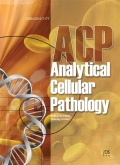Authors: Levitus, Marieke | Joenje, Hans | de Winter, Johan P.
Article Type:
Research Article
Abstract:
Fanconi anemia (FA), a recessive syndrome with both autosomal and X-linked inheritance, features diverse clinical symptoms, such as progressive bone marrow failure, hypersensitivity to DNA cross-linking agents, chromosomal instability and susceptibility to cancer. At least 12 genetic subtypes have been described (FA-A, B, C, D1, D2, E, F, G, I, J, L, M) and all except FA-I have been linked to a distinct gene. Most FA proteins form a complex that activates the FANCD2 protein via monoubiquitination, while FANCJ and FANCD1/BRCA2 function downstream of this step. The FA proteins typically lack functional domains, except for FANCJ/BRIP1 and FANCM, which are
…DNA helicases, and FANCL, which is probably an E3 ubiquitin conjugating enzyme. Based on the hypersensitivity to cross-linking agents, the FA proteins are thought to function in the repair of DNA interstrand cross-links, which block the progression of DNA replication forks. Here we present a hypothetical model, which not only describes the assembly of the FA pathway, but also positions this pathway in the broader context of DNA cross-link repair. Finally, the possible role for the FA pathway, in particular FANCF and FANCB, in the origin of sporadic cancer is discussed.
Show more
Keywords: Fanconi anemia, cancer, genetic predisposition
Citation: Analytical Cellular Pathology,
vol. 28, no. 1-2, pp. 3-29, 2006
Price: EUR 27.50





